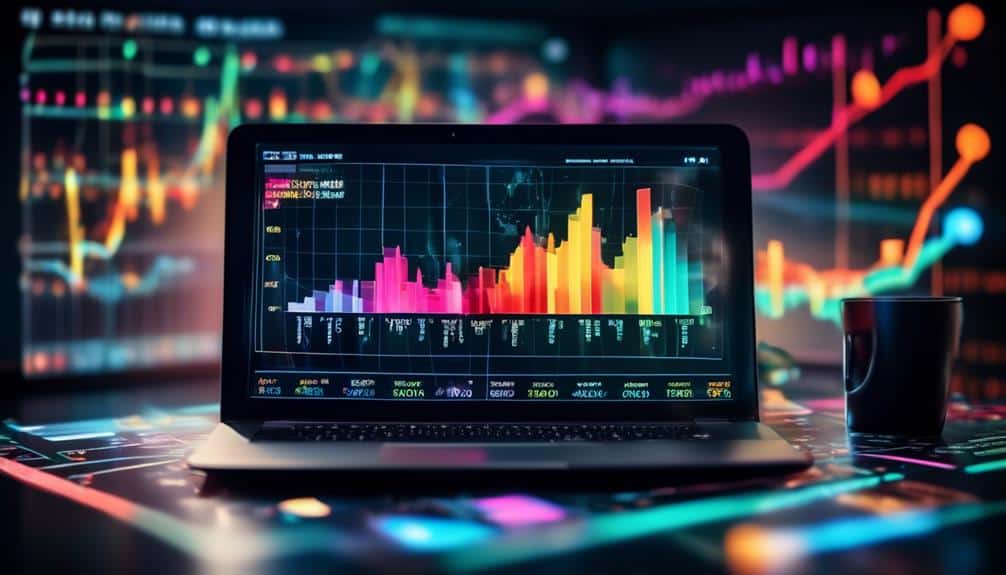The Algorithmic Eye: AI-Powered Tools for Uncovering Social Media Behaviors
Ever wished you had a digital Sherlock Holmes to uncover the mysteries of social media behaviors? Well, in the world of AI-powered tools, that wish might just be a reality.
As you navigate the vast landscape of social media platforms, have you ever pondered on the intricate algorithms silently observing your every digital move?
The intersection of artificial intelligence and social media analysis has birthed a new era of insight and scrutiny, shedding light on user behaviors, sentiment trends, and influencer dynamics that will make you question the very fabric of your online presence.
Key Takeaways
- AI integration in social media analysis enables real-time trend analysis and insights for marketing strategies and product development.
- Sentiment analysis techniques help in understanding user sentiment, predicting consumer preferences, and tailoring effective strategies.
- Data-driven influencer identification methods and engagement analytics assist in selecting influencers effectively and assessing their impact.
- AI-powered social listening and influence scoring algorithms aid in monitoring conversations, identifying trends, and ranking influencers based on engagement data.
Evolution of Social Media Analysis

The evolution of social media analysis has revolutionized how businesses and individuals understand online interactions and trends. Through the integration of artificial intelligence (AI) into social media platforms, a new era of insight and understanding has emerged. AI integration has enabled the processing of vast amounts of data at speeds and scales previously unimaginable, allowing for real-time analysis of social media trends and behaviors.
With AI-powered tools, businesses can now delve deeper into the wealth of information available on social media platforms, uncovering valuable insights that can inform marketing strategies, product development, and customer engagement. However, this advancement also raises ethical AI implications, as the use of AI in social media analysis requires careful consideration of privacy, bias, and data security.
Role of AI in Data Mining
AI's integration into social media analysis hasn't only transformed how businesses and individuals comprehend online interactions but is also reshaping the landscape of data mining by enabling unprecedented insights from vast amounts of social media data in real-time. Machine learning applications play a vital role in data mining by automating the process of extracting valuable information from social media platforms. These applications can sift through immense datasets at incredible speeds, identifying patterns and trends that would be impossible for humans to discern manually.
Data visualization techniques further enhance the efficacy of AI in data mining by presenting complex relationships and insights in easily digestible formats. By leveraging these techniques, businesses can quickly grasp the significance of the data extracted from social media sources, enabling them to make informed decisions promptly. Additionally, AI-powered tools facilitate predictive analytics, allowing organizations to anticipate future trends based on historical social media data analysis.
Through the synergy of machine learning applications and data visualization techniques, AI is revolutionizing the field of data mining, empowering users to unlock actionable insights from the vast sea of social media data.
Sentiment Analysis Techniques

Utilizing advanced algorithms, sentiment analysis techniques enable the extraction of emotional insights from social media data. Emotion detection algorithms lie at the core of this process, allowing for the automatic identification and categorization of sentiments expressed in online content. These algorithms analyze text, images, and videos to determine the underlying emotions conveyed by users, providing valuable information for businesses and researchers alike.
Behavioral sentiment analysis further enhances this capability by considering not only the explicit emotions expressed but also the underlying behaviors and patterns exhibited by individuals on social media platforms. By combining emotional cues with behavioral data, a more comprehensive understanding of user sentiment can be achieved, leading to more accurate predictions and targeted interventions.
In essence, sentiment analysis techniques serve as a powerful tool for uncovering the nuanced emotional landscape of social media. Through the application of emotion detection algorithms and behavioral sentiment analysis, businesses can gain valuable insights into consumer preferences, trends, and sentiments, ultimately driving more informed decision-making processes in the digital age.
Uncovering User Behavior Patterns
Uncovering user behavior patterns involves analyzing interactions and engagements on social media platforms to identify trends and preferences. By delving into behavior analysis, AI-powered tools can provide valuable user insights that help businesses tailor their strategies effectively.
Here are three ways these tools uncover user behavior patterns:
- Content Consumption Analysis: AI algorithms can track what type of content users engage with the most, whether it's videos, images, or text. This analysis helps in understanding user preferences and crafting content that resonates with the audience.
- Time-of-Day Engagement Patterns: By analyzing when users are most active on social media, AI tools can pinpoint the best times to post content for maximum engagement. This insight ensures that posts reach the target audience when they're most likely to interact.
- User Interaction Mapping: AI tools can map out how users interact with a brand's social media accounts, highlighting which posts receive the most likes, comments, or shares. This mapping provides a comprehensive view of user behavior, aiding in refining content strategies for better engagement.
Influencer Identification Methods

When identifying influencers, utilizing data-driven methods is crucial for effective selection. AI-powered tools can provide in-depth audience analysis, helping pinpoint the most suitable influencers for a specific target group.
Evaluating social engagement metrics is also pivotal in determining an influencer's impact and reach.
Data-Driven Influencer Selection
Data analysis plays a pivotal role in the process of selecting influencers for marketing campaigns on social media platforms. To enhance your influencer marketing strategy, consider leveraging data insights to pinpoint the most suitable influencers.
Here are three key methods for data-driven influencer selection:
- Audience Alignment: Utilize data analytics to identify influencers whose audience demographics align with your target market, ensuring maximum reach and engagement.
- Engagement Metrics: Analyze engagement rates, comments, likes, and shares to gauge an influencer's impact on their audience and assess their potential effectiveness for your campaign.
- Content Relevance: Evaluate the relevance of an influencer's content to your brand's message by using sentiment analysis and topic modeling to ensure brand fit and authenticity.
Ai-Powered Audience Analysis
Utilizing AI-powered algorithms enhances the precision and efficiency of identifying influencers through audience analysis methods. Audience segmentation allows for the categorization of followers based on demographics, interests, and behavior patterns.
Engagement analysis delves into the level of interaction and response generated by different types of content. By analyzing these metrics, AI can pinpoint the most influential individuals within specific audience segments.
Content optimization becomes more targeted as AI identifies trends and preferences among followers, enabling influencers to tailor their posts for maximum impact. Trend identification through AI-powered tools ensures that influencers stay ahead of the curve, producing content that resonates with their audience in real-time.
Embracing AI in audience analysis revolutionizes influencer identification, making it data-driven and results-oriented.
Social Engagement Metrics
AI-powered algorithms revolutionize influencer identification by analyzing social engagement metrics to pinpoint the most influential individuals within specific audience segments. Through engagement analytics and social listening techniques, these tools delve deep into user interactions and behaviors to uncover the most impactful voices in the digital realm.
- Engagement Analytics: These algorithms track likes, comments, shares, and other forms of interaction to gauge the level of engagement an influencer generates.
- Social Listening Techniques: By monitoring conversations, trends, and sentiments across social media platforms, AI can identify key players who resonate with their audience.
- Influence Scoring: Advanced algorithms assign influence scores based on engagement data, providing a quantitative measure of an influencer's impact.
Detecting Fake News and Bots

You can rely on advanced bot detection techniques to sift through vast amounts of social media data efficiently.
By identifying specific patterns associated with misinformation, AI tools can help pinpoint fake news sources accurately.
Fake news analysis is crucial in understanding the spread of false information and its impact on online discourse.
Bot Detection Techniques
When detecting fake news and bots on social media platforms, advanced bot detection techniques play a crucial role in safeguarding the integrity of online information.
Utilizing bot classification methods and machine learning approaches, algorithms can efficiently distinguish between authentic users and automated accounts.
Deep learning algorithms enhance this process by analyzing intricate patterns in user behavior, helping to identify suspicious activities that indicate bot presence.
Additionally, natural language processing (NLP) techniques aid in recognizing linguistic cues that are common in bot-generated content, further refining the detection process.
Identifying Misinformation Patterns
Identifying misinformation patterns involves analyzing data to discern inconsistencies and anomalies that may indicate the presence of fake news or automated accounts on social media platforms. Misinformation detection and behavioral analysis play crucial roles in uncovering deceptive practices online. By utilizing AI-powered tools, researchers and analysts can sift through vast amounts of data to identify suspicious patterns that deviate from normal human behavior.
| Misinformation Detection | Behavioral Analysis |
|---|---|
| Identifying fake news articles | Analyzing posting frequency |
| Detecting bot-generated content | Examining engagement patterns |
| Verifying sources | Assessing account creation dates |
These techniques help in flagging potentially misleading information and distinguishing between authentic user activity and automated manipulation, contributing to a more informed and trustworthy online environment.
Fake News Analysis
In the realm of social media analysis, uncovering deceptive practices online involves scrutinizing patterns to detect fake news and bot-generated content. When it comes to Fake News Analysis, advanced AI-powered tools play a crucial role in identifying and combating misinformation.
Here are three key methods used in fake news detection and misinformation identification:
- Natural Language Processing (NLP): Leveraging NLP algorithms to analyze the language and context of social media posts to flag potentially deceptive content.
- Network Analysis: Mapping out the connections between accounts to uncover coordinated efforts in spreading fake news or misinformation.
- Sentiment Analysis: Utilizing sentiment analysis algorithms to gauge the emotional tone of posts, helping identify potentially misleading information.
Personalization in Marketing Strategies

Harnessing the power of AI-powered tools allows marketers to dynamically tailor content to individual preferences, enhancing the effectiveness of personalization in marketing strategies. By utilizing advanced algorithms, customer segmentation becomes more refined, enabling targeted advertising that resonates with specific audience segments. The ability to analyze vast amounts of data in real-time empowers marketers to deliver personalized experiences that drive engagement and conversions. Personalization not only improves customer satisfaction but also boosts brand loyalty, as individuals feel understood and valued by the brand.
—
| Benefits of Personalization in Marketing Strategies | |
|---|---|
| Enhanced Customer Engagement | Personalized content increases interaction and builds rapport |
| Improved Conversion Rates | Tailored recommendations lead to higher conversion rates |
| Increased Brand Loyalty | Customized experiences foster stronger connections with the brand |
| Efficient Resource Allocation | Targeted marketing reduces wasted resources on irrelevant audiences |
| Real-Time Campaign Optimization | AI allows for instant adjustments based on customer behavior |
Privacy Concerns and Ethical Considerations
Utilizing AI-powered tools in social media behaviors raises critical concerns regarding privacy and ethical considerations. When delving into the realm of data-driven insights derived from social media activities, it's essential to address the following key points:
- Ethical Considerations: The use of AI in analyzing social media behaviors can blur the lines between what's considered ethical and intrusive. It's crucial to establish clear ethical guidelines to govern the collection and utilization of user data to prevent potential misuse.
- Privacy Implications: The automated nature of AI tools can lead to extensive data collection without explicit user consent. Striking a balance between leveraging user data for insights and respecting individual privacy rights is imperative to maintain trust and transparency.
- User Consent and Data Protection: Ensuring that users actively consent to the collection and analysis of their social media behaviors is paramount. Additionally, robust data protection measures must be in place to safeguard sensitive information from breaches or unauthorized access.
Navigating the complex landscape of AI-powered social media tools requires a proactive approach towards addressing ethical dilemmas and privacy concerns to foster responsible and sustainable practices.
Future Trends in AI Social Analysis

To stay ahead in the ever-evolving landscape of social media analysis, understanding emerging trends in AI technology is crucial for optimizing data insights and strategic decision-making. AI forecasting trends play a pivotal role in shaping the future of social media analysis.
One key trend to watch is the increasing integration of natural language processing (NLP) algorithms in AI social analysis tools. NLP enables these tools to extract valuable insights from text data, offering a deeper understanding of user sentiments and behaviors on social media platforms.
Another significant trend is the advancement of image and video recognition capabilities in AI-powered analysis tools. These developments allow for more comprehensive analysis of visual content shared on social media, providing valuable insights into user preferences and interactions.
Frequently Asked Questions
How Do AI Algorithms Adapt to Cultural and Regional Differences in Social Media Behaviors?
To adapt to cultural nuances, AI algorithms analyze social media behaviors, adjusting strategies to regional variations. By recognizing diverse online interactions, these tools refine their approaches, enhancing understanding and tailoring content for specific audiences effectively.
What Are the Potential Risks of Relying Solely on Ai-Powered Tools for Uncovering Social Media Behaviors?
When relying solely on AI-powered tools for uncovering social media behaviors, ethical considerations such as potential biases and accuracy must be acknowledged. Data privacy concerns arise as sensitive information may be mishandled or misinterpreted.
How Do Sentiment Analysis Techniques Account for Sarcasm and Irony in Social Media Posts?
To detect humor effectively in social media posts, sentiment analysis techniques must grasp linguistic nuances and interpret text within context. It's crucial for algorithms to comprehend sarcasm and irony, enhancing accuracy in sentiment evaluation.
Can AI Accurately Predict Future User Behavior Patterns Based on Past Data Analysis?
You can explore the predictive accuracy of AI in forecasting user behavior patterns. However, be mindful of data analysis limitations that may impact the reliability of these predictions. AI's potential lies in adapting to evolving trends.
What Are the Limitations of Current Influencer Identification Methods in Detecting Genuine Influence on Social Media Platforms?
Identifying genuine influencers poses challenges due to limitations in current methods for authenticity detection. Enhancing algorithms to sift through engagement metrics and content quality is crucial for accurate influence assessment on social media platforms.
Conclusion
In conclusion, AI-powered tools have revolutionized social media analysis by uncovering user behavior patterns, identifying influencers, and detecting fake news and bots.
These tools have enabled personalized marketing strategies while raising privacy concerns and ethical considerations.
As technology continues to advance, the future of AI social analysis will likely focus on more sophisticated algorithms and automation to provide deeper insights into online behaviors and trends.
Stay informed and adapt to the ever-evolving landscape of social media analysis with AI-powered tools.








